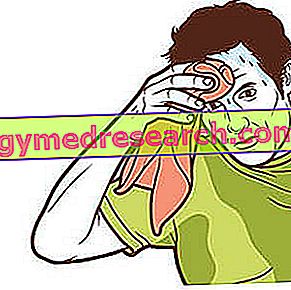Watch the video
X Watch the video on youtubeGenerality
Pharyngitis, commonly called sore throat, is an inflammation that affects the pharynx. The latter, located at the back of the mouth, is a muscle-membranous channel that allows food to take the path of the esophagus.

Figure: sore throat and pain when swallowing are the characteristic symptoms of pharyngitis.
Pharyngitis can be due to various causes, including viruses (main culprits), bacteria, allergies, gastric juice rising from the stomach, etc.
Those who suffer from pharyngitis experience an annoying sensation in the throat and feel pain when they swallow. Furthermore, if an infectious agent causes inflammation, it is likely that the patient will also experience disorders of the related infectious disease.
Generally, pharyngitis heals in a few days and without special treatment; however, if symptoms persist, more extensive diagnostic tests and specific therapy may be required.
What is pharyngitis?
Pharyngitis is inflammation of the pharynx, or the posterior region of the mouth.
In common parlance, pharyngitis is better known as sore throat, a symptom that characterizes various pathological circumstances.
Pharyngitis can occur in an acute (sudden) manner and resolve within a few days, or it can become chronic and persist for long periods. In the latter case we speak of chronic pharyngitis .
WHAT IS FARINGE?
The pharynx is a muscle-membranous conduit about 13 centimeters long, covered by a mucosa and located between the nasal cavity and the esophagus. To be even more precise, the pharynx resides:
- Postero-inferior to the nasal cavity (ie behind and lower than the nasal cavity)
- Back to the mouth
- Above the larynx and esophagus
The pharynx is a fundamental trait of the upper digestive airways, so called because they allow both the progression of food to the esophagus and the passage of air destined for the lungs, for breathing.
In the pharynx, three compartments can be recognized: the nasopharynx (or nasopharynx ), the oropharynx and the hypopharynx (or laryngopharynx ).
The nasopharynx is the upper part of the pharynx, placed in direct contact with the choanae, or the two posterior openings of the nasal cavity.
The oropharynx is the intermediate portion of the pharynx, located between the nasopharynx and epiglottis (the latter represents the upper end of the larynx). In front of him, he has the oral cavity, with which he communicates through the so-called jaw isthmus .
Finally, the hypopharynx is the terminal portion of the pharynx, which feeds food into the esophagus. Being located a little lower than the epiglottis, unlike the other two sections, it is not crossed by air but only by food.

Figure: the sections that make up the pharynx (highlighted in red) and the anatomical parts adjacent to them (in black). Anatomically, the pharynx extends from the base of the skull to the VI cervical vertebra. From here on, the esophagus begins, a tube about 25-30 centimeters long that serves to conduct food in the stomach; food that does not take the path of the larynx, thanks to the presence of the epiglottis. From the site: memorize.com
The last section of the pharynx is positioned at about the same level as the VI cervical vertebra and the cricoid cartilage belonging to the larynx.
Causes
Pharyngitis can occur for different reasons.
In most cases, it is the result of a viral infection ; less commonly, it can be the result of a bacterial infection or particular circumstances, such as allergies, gastroesophageal reflux disease or exposure to toxic chemicals.
A more accurate description of the possible causes of pharyngitis is given in the following sub-chapters.
VIRGINAL INFECTIONS
The main and most common viruses capable of causing pharyngitis are:
- Cold viruses such as: Rhinovirus, Coronavirus, Parainfluenza virus, respiratory syncytial virus, Adenovirus, Enterovirus and Metapneumovirus
- Influenza viruses
- The mononucleosis virus, or Epstain-Barr virus
- The measles virus
- Chickenpox virus (also called Herpes virus 3 or varicella-zoster virus)
BACTERIAL INFECTIONS
The main bacteria that can ignite the pharynx are:

- Streptococcus pneumoniae
- Haemophilus influenzae
- Bordetella pertussis
- Bacillus anthracis
- Corynebacterium diphtheriae
- Neisseria Gonorrhoeae
- Chlamydophila pneumoniae
- Mycoplasma pneumoniae
OTHER CAUSES
Episodes of pharyngitis may also occur due to:
- Allergic reactions . The pharynx of people allergic to mold, dust, pollen or animal hair is subject to repeated inflammation. In all these circumstances, it is very likely that the so-called post-nasal (or nasopharyngeal) drip occurs, due to a massive presence of mucus at the point of communication between the nasal cavity and nasopharynx.
- Dryness of the home or work environment . The heating with which the buildings (houses, offices, etc.) become warmer can dry out the air. Dry air, if breathed for several hours, can inflame the pharynx, as it causes nasal congestion and causes you to breathe with your mouth. Dry pharyngitis is a frequent problem among those who sleep in heated (and not humidified) rooms all night.
- Chronic inhalation of irritants . The polluted air, cigarette smoke and toxic fumes of some industrial plants contain irritants for the throat, which can inflame the various sections of the pharynx.
- Excessive pharyngeal muscle strain . The pharynx muscles are like the muscles of the legs and arms; therefore, if subjected to excessive effort (such as when talking for a long time or shouting), they get tired and become inflamed, causing all the typical symptoms of sore throat.
- Ascent of the acid content of the stomach (gastric reflux), towards the esophagus, pharynx and sometimes also larynx . People with recurrent episodes of gastroesophageal reflux (NB: gastroesophageal reflux disease) or pharyngolaryngeal reflux are subject to frequent inflammations not only of the esophagus (esophagitis), but also of the pharynx and larynx (laryngitis). The acidity of the gastric juices rising and the extreme sensitivity of the aforementioned anatomical structures give rise to the inflammatory process.
- AIDS . The first stages of AIDS are characterized by a series of symptoms, reminiscent of an influence. Among the various ailments, there is also a sore throat.
Furthermore, AIDS patients are immunosuppressed (ie with poor immune defenses) and this predisposes them to various infectious diseases, some of which ignite the pharynx.
- Malignant tumors at the level of the pharyngo-laryngeal or oral cavity . Sore throat is one of the symptoms of cancer of the pharynx, larynx or tongue. It is usually associated with other symptoms, such as: problems with swallowing, hoarseness, the emission of strange noises during breathing, blood in saliva and the appearance of bumps on the neck.
- Peritonsillar abscesses or epiglottitis . An abscess is a collection of pus, bacteria, cellular debris and plasma, which is formed following an infection. A peritonsillar abscess is an abscess located between the tonsils and the pharynx.
The epiglottitis is the inflammation of the epiglottis, the laryngeal valve that regulates the passage of air in the trachea and prevents the food introduced from obstructing the airways. Severe epiglottitis can cause serious respiratory problems.
Peritonsillar abscesses and epiglottitis represent two conditions to be kept under close observation, since, if neglected, they could lead to serious complications.

RISK FACTORS
Anyone can get pharyngitis, but they are more susceptible:
- Children and adolescents .
- Smokers and those who chronically breathe passive smoking .
- Those with allergies .
- Those who, for work reasons, breathe chemical irritants, toxic dust, etc.
- Those who suffer from chronic sinusitis . Chronic sinusitis is an inflammatory state that affects the nasal and paranasal sinuses.
- Those who attend or live in crowded places, such as students, kindergarten children, barracks, prisoners, etc.
- Immunosuppressed . The immune system is the body's protective barrier against pathogens and threats from the external environment. Therefore, those who are immunosuppressed are more likely to contract viral, bacterial, fungal infections, etc. AIDS, diabetes, corticosteroid intake, chemotherapy, leukemia, immunosuppressive drugs (for example after an organ transplant) and aplastic anemia are just some of the causes that suppress the immune system of a person.
Symptoms and Complications
To learn more: Symptoms Pharyngitis
The symptoms and signs of sore throat strongly depend on the triggering causes, therefore each patient represents a case in itself. Nevertheless, most pharyngitis episodes are characterized by:
- Pain or itching in the back of the mouth
- Pain that becomes more acute every time you swallow or when you talk
- Difficulty in swallowing as in normal conditions
- Dry throat
- Enlarged and inflamed lymph nodes of the neck and jaw
- Reddened and reddened tonsils
- Presence of white or pus-colored plaques on the tonsils
- Hoarse voice ( hoarseness ) and / or weak
WHEN AT THE ORIGIN THERE IS A BACTERIAL OR VIRAL INFECTION
If pharyngitis is the result of a viral or bacterial infection, in addition to the previously reported manifestations, you may have fever above 38 ° C, chills, cough, runny nose, sneezing, muscle and joint pain, headache, nausea and vomiting.
WHEN TO CALL THE DOCTOR?
If the sufferer is a child, it is advisable to contact the doctor in the presence of breathing difficulties, difficulty in swallowing and persistent burr in the mouth (sign of a swallowing problem).
If instead the sufferer is an adult, it is advisable to call the doctor in the presence of:
- Severe sore throat, which has been ongoing for more than a week and, instead of improving, tends to worsen.
- Swallowing disorders, breathing difficulties and / or problems opening the mouth
- Joint pain
- Bad ears
- Rash (or skin rash or rash)
- Blood in saliva or phlegm
- High fever
- Recurrent episodes of sore throat
- Lumps on the neck
- Persistent hoarseness (over two weeks)
Diagnosis
Individuals who require a medical consultation due to a severe sore throat are first subjected to a thorough physical examination and a thorough analysis of their medical history.
After that, depending on the situation and if there are any doubts about the causes, the doctor could prescribe the execution of a throat swab, a blood sample or allergy tests.
EXAMINATION OBJECTIVE
During the physical examination, the doctor visits the patient and asks him to describe the symptoms felt.
The visit consists in observing, with a micropile and adequate instrumentation, the throat, ears and nasal nostrils, in palpation of the neck and submandibular regions in search of possible swollen lymph nodes and in auscultation of the thorax through a stethoscope.
ANALYSIS OF CLINICAL HISTORY
Analyzing a patient's clinical history means asking him about the particular diseases he has suffered in the past, what his health status is at the time of the check (sore throat aside), what drugs he takes, what work he does, if he is a smoker, etc. These questions could be used by the doctor to explain non-infectious pharyngitis.
FARINGEO BUFFER AND BLOOD COLLECTION
The doctor submits the patient to a throat swab and a blood sample to determine if there is an ongoing infectious disease and identify it.
Going into more detail, the swab detects bacterial infections, while blood tests make it possible to trace both viruses and bacteria; therefore (from the diagnostic point of view) they represent a more exhaustive control.
Overall, however, both procedures are quick, inexpensive and completely harmless for the patient.
ALLERGIC TESTS
If there is a suspicion that pharyngitis is caused by an allergy to some volatile substances and not only (dust, toxic substances, mold, pollen, animal hair, etc.) the doctor will surely prescribe allergy tests .
WHAT SPECIALIST IS IT BETTER TO CONTACT?
Often, when an individual suffers from recurring sore throats, he is asked by his primary care physician to contact an otolaryngologist, or a doctor who specializes in treating ear, nose and mouth diseases.
Treatment
To learn more: Medications for the treatment of pharyngitis
For viral-type pharyngitis, no specific treatment is provided, but only symptomatic remedies, that is aimed at reducing the symptoms. In these cases, healing usually takes 5 to 7 days .
On the other hand, for bacterial pharyngitis and pharyngitis due to particular conditions (allergies, gastric reflux, etc.), the situation is different: in the first case, if the conditions require it, antibiotic treatment is necessary, while in the second, a therapy based specifically on the triggering causes must be set.
SOME REMEDIES TO EFFECTIVELY RELIEVE SYMPTOMS
To mitigate the symptoms of sore throat, especially if it is caused by a virus, doctors recommend:
- Stay at rest, sleeping 7-8 hours a night and not tiring the voice.
- Take plenty of fluids, especially water, to avoid getting dehydrated. Alcoholic beverages and coffee should be avoided until complete resolution of symptoms.
- Gargle with solutions based on heated water and salt, as they are very useful in alleviating throat inflammation.
- Make hot-humid inhalations, to reduce the sense of dry throat and free the respiratory tract from mucus. Always with the same goals, doctors also recommend hot showers and the use, in rooms where you spend most of your time, of a portable humidifier to make the air less dry.
- Take anti-inflammatory and pain-relieving drugs, such as paracetamol, ibuprofen or aspirin . These medicines are particularly suitable when the patient feels an annoying throat pain, headache, fever, swallowing discomfort, joint pain, etc.
Warning: aspirin should not be given to individuals under the age of 16, as it may cause the so-called Reye's syndrome.
- Do not smoke, avoid breathing passive smoke and do not frequent dusty and dry environments.
THERAPY IN THE CASE OF BACTERIAL INFECTIONS
In case of severe or potentially dangerous bacterial pharyngitis, the doctor opts for antibiotic therapy . The most prescribed antibiotic medicines are penicillin and its derivatives.
The route of administration is usually oral and treatment generally lasts until the symptoms are resolved.
Caution:
- The intake of antibiotics must take place exclusively on the instructions of the attending physician . Taking antibiotics without a specific reason or without a real need leads to the proliferation of bacteria resistant to the antibiotics themselves; in this regard, keep in mind that mild bacterial infections associated with pharyngitis can resolve spontaneously
- It is advisable for the patient to comply with the doses and methods of administration established by the physician, as any early termination of the treatment or an incorrect use of the antibiotic can render the therapy conducted up to that point completely vain.
Prevention
To prevent pharyngitis due to infectious infectious agents, doctors advise to take care of their personal hygiene and to sanitize from time to time the environment in which they live. Therefore, it is a good idea to wash your hands frequently (especially after using the bath) with soap and water or, alternatively, with alcohol-based towels; avoid sharing food, cutlery, glasses, etc. with other people; avoid placing your mouth on public telephones; clean your home phone, TV remote control, computer keyboard, etc. with appropriate detergents regularly; if you are traveling, sanitize the hotel room or apartment where you are staying; finally, avoid direct contact with people suffering from some viral or bacterial disease.
To prevent pharyngitis associated with causes other than infectious diseases, it is good practice: if you treat toxic chemicals, irritating powders, etc., wear masks for filtering air; if you live in a particularly polluted city, avoid spending too much time outdoors in the days of greatest smog; not smoking; avoid breathing passive smoke; finally, humidify your home or workplace to prevent the air from drying out too much.
Prognosis
In general, viral and bacterial pharyngitis have a positive prognosis: in fact, most patients recover within a few days.
However, the case of sore throats not associated with infectious diseases is different: in these situations, the prognosis depends on how serious the triggers are.




